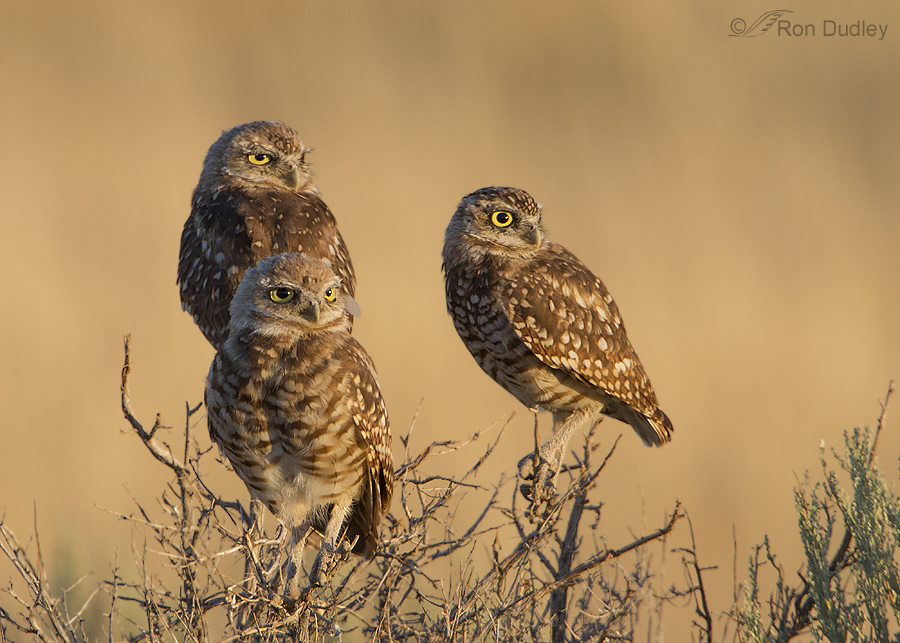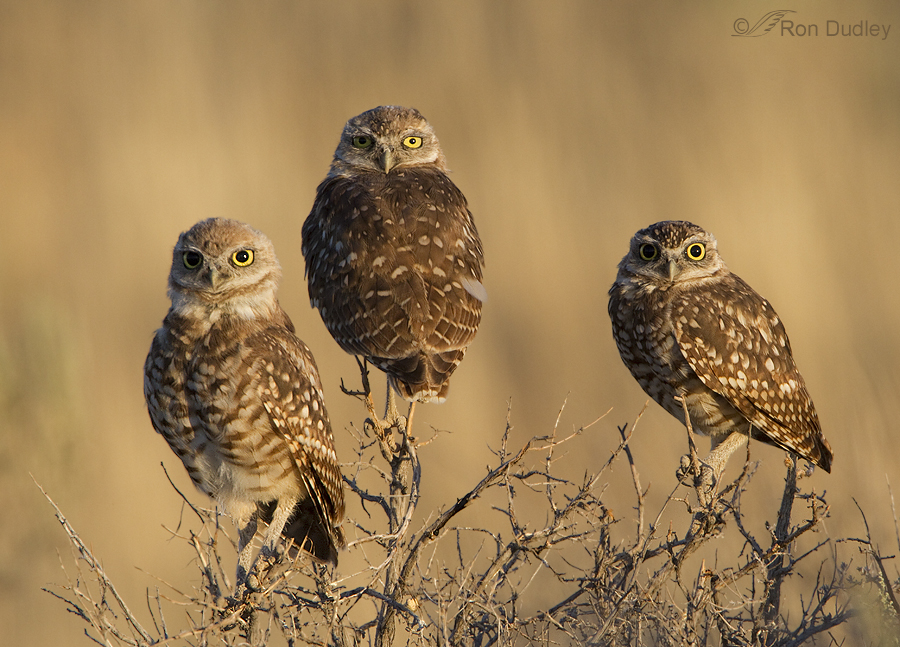Yesterday’s post about a Red-tailed Hawk and depth of field reminded me of a wonderful but frustrating opportunity I had with Burrowing Owls several years ago on Antelope Island so I decided to revisit those shots to see what I could salvage. One of the difficulties with shooting with a long lens is dealing with the very narrow depth of field you have to work with and for obvious reasons that issue often becomes compounded when there’s several birds in the frame.
I’d been photographing a family of these birds for several weeks but typical of the species they were usually on the ground with obstructing vegetation in front of them or buried too deeply in the sagebrush. But as I approached them on this early August morning (in my pickup, from the road) there were two juveniles and one adult perched high on the sagebrush in nice warm light and there was a clean, pleasing background. My little heart went pit-a-pat at the opportunity but then I had to deal with the harsh reality of depth of field.
1/200, f/13, ISO 500, 500 f/4, 1.4 tc, not baited, set up or called in
The juvenile in front was probably about a foot closer to me than the other two birds – that’s a lot of depth to get sharp when you’re effectively shooting at 1120 mm (500mm lens x 1.4 tc x 1.6 crop factor of the Canon 7D). I was all over the place with my settings and focus points trying to get all three birds as sharp as possible and of course I had to deal with the poses of the birds, too. In reviewing the images it seemed that the sharpest shots had at least one of the birds looking away (naturally…).
Then I decided to creep forward a little to see if I could get all three birds isolated from each other.
1/200, f/13, ISO 500, 500 f/4, 1.4 tc, not baited, set up or called in
It worked but I only had a few seconds with them before one of the birds flew off so I didn’t have much opportunity to play with my settings from this vantage point.
I posted a smaller version of this image when I first started blogging (when not many folks knew I was “out there” so I suspect few have seen it) and at the time I lamented the fact that the juvenile on the left is slightly soft compared to the other two. But this time I applied a bit more sharpening to the softer bird and to my eye the overall results are now within the acceptable range.
Even though neither of these images are among the sharpest in my portfolio I still like them a lot – if for no other reason than as a reminder of time spent with three wonderful birds in a magical setting.
Ron




Wonderful light and an outstanding capture. Exquisite, Ron.
Thanks very much, Jim. Hope to see you guys on one of your trips down to the “warmer climes” this winter.
Wonderful, Ron. May I ask, which bird did you focus on at f13? I always get confused by that.
Melissa, In situations like this (multiple birds and time to take a few shots if they don’t change relative position) I experiment with different focus points and hope for the best in at least a few of them. At different times I focused on each bird and on points in-between. For quite a few of these images I was (attempting) to focus on the twigs between the two owls on the right because of their intermediate depth relative to all three birds.
Ron, it so great to read your comments while viewing your truly amazing photographs. Thanks for sharing your expertise and photos!
Thanks, Pamela. I get a lot out of the comments here, too.
OOOOOOOOOOOOOHHHHHHHHH! They are gorgeous. Thank you for sharing!
Thank you, Nicole.
Holy geez, are these birds on drugs??? JK- wonderful shots Ron.
I don’t think so, Shyloh – they were on “voles”. 🙂
I am so very grateful that you and Mia share the beauty of the birds you see. Share stunning images, wonderful information, and I am so impressed with your ethical approach. Thank you.
I appreciate your kind comments, Elephant’s Child.
They are special shots with the three together and that lovely light, and such an appealing bird. Thanks for sharing them.
Thank you, Sonja.
I love the photos Ron. My favorite part of the second photo is the different pupil sizes of each bird. I understand your frustration with the depth of field. I had a lot of trouble with the same issues with shorebirds this summer, and having very active subjects only compounds the frustration. You nailed it with these birds though, as the “softness” of the bird on the left is hardly noticeable.
Bryce, I meant to mention those varying pupil sizes in my text and completely spaced it out. Thanks for bringing it up.
I stumbled upon your blog when I googled Harrier Falcon to help identify one we had flying around our Iowa acreage. It fast became one of my favorite blogs. I am a photographer that is only documenting family life but I certainly enjoy your quality of work. I love your photos! I also love the scientific information you provide. I too was wondering about the different size of pupils? Why are they different sizes in the same light?
Welcome, Teresa. In both photos it’s the bird in the rear (the adult) whose pupil is significantly smaller than the others but I really don’t know why that’s the case. These birds were quickly moving their heads to look in different directions (which would alter the amount of light entering the eye) and at first I wondered if perhaps the pupil just hadn’t had time to accommodate when the shutter fired, but that’s unlikely to have happened twice, IMO…
The photos of the burrowing owls are among my favorites of all your photos.
Thank you very much, Ilona.
Very nice clinic on depth of field with a longer lens. I frequently encounter the same situation and try to get shots with different settings to see which turns out the best in a given situation. As you pointed out, the birds are not usually as patient as we are!
Superb photographs, Ron!
You’re right, Wally – they usually don’t give us enough time to dink around much with settings.
These are fun shots, and I especially like the second one. In the first one, even though I’ve looked long and hard, I find it difficult to tell that the bird on the left is ‘soft’. Maybe it would show up more on a larger computer screen (mine is 13″), but even so I like the shot a lot. At least for me it is more important that we get to see the birds, and the quality of these shots would satisfy most of us… 🙂 I wish I could achieve this level of perfection in anything!
Susan, I should have been more clear. I think all three birds in the first shot are moderately sharp. It’s the second shot only where the bird on the left is softer than the others.
Thanks, Ron. I’ve checked the second photo again, and I still have trouble finding anything wrong with it. The bird may look a little fluffier to me, but that’s it.
Hi Ron – these are absolutely priceless shots! My preference is the second one. Lucky you, getting three in a row like that.
Cheers, Paul.
I probably lean toward that shot too, Paul – mostly for the separation of the birds. Thank you.
Fantastic and wonderful shots from the perfectionist! Thanks for sharing Ron!
Charlotte
I’m glad you liked them, Charlotte.
These photos are so wonderful!!! They take my breath away. I have depth of field problems just shooting anything…flowers that are not moving. These owls are just so great.
Thanks very much, Ellen.